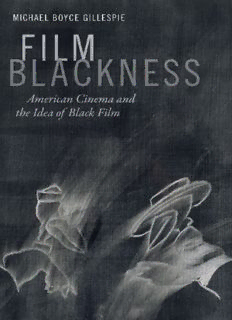
Film Blackness : American Cinema and the Idea of Black Film PDF
Preview Film Blackness : American Cinema and the Idea of Black Film
Film Blackness MICHAEL BOYCE GILLESPIE F I L M B L A C K N E S S American Cinema and the Idea of Black Film Duke University Press Durham and London 2016 © 2016 Duke University Press All rights reserved Printed in the United States of America on acid- free paper ∞ Designed by Heather Hensley Typeset in Garamond Premier Pro by Graphic Composition, Inc., Bogart, Georgia Library of Congress Cataloging- in- Publication Data Names: Gillespie, Michael Boyce, [date] author. Title: Film blackness : American cinema and the idea of black film / Michael Boyce Gillespie. Description: Durham : Duke University Press, 2016. | Includes bibliographical references and index. Identifiers: lccn 2016010797 isbn 9780822362050 (hardcover : alk. paper) isbn 9780822362265 (pbk. : alk. paper) isbn 9780822373889 (ebook) Subjects: lcsh: African Americans in motion pictures. | Race in motion pictures. | Motion picture industry—United States. Classification: lcc pn1995.9.n4 g55 2016 | ddc 791.43 / 6 52996073—dc23 lc record available at http: // lccn .loc .gov / 2016010797 Cover art: Gary Simmons, Erasure Series (#1 black), 1992. Chalk and slate paint on paper. Collection of Peter Norton. For Nathaniel and Benjamin. My everythings. CONTENTS ix Acknowledgments 1 Introduction We Insist: The Idea of Black Film 17 one Reckless Eyeballing: Coonskin and the Racial Grotesque 51 two Smiling Faces: Chameleon Street and Black Performativity 83 three Voices Inside (Everything Is Everything): Deep Cover and Modalities of Noir Blackness 119 four Black Maybe: Medicine for Melancholy, Place, and Quiet Becoming 157 Coda Destination Out 161 Notes 203 Bibliography 223 Index ACKNOWLEDGMENTS This book is a product of years of thinking about the art of blackness. This is not the Atom Egoyan or Japanese New Wave book I once thought I would write. I blame many writers and artists for that, too many to list here. But I especially feel that Randall Kenan’s Walking on Water: Black American Lives at the Turn of the Twenty- First Century was significantly responsible. Further- more, I don’t think I would be a scholar if not for Dr. Linda G. Zatlin at Morehouse College. My mentor, friend, and believer. I am immensely grateful for my professors and advisors at New York Uni- versity. My deep thanks to Ed Guerrero, Bob Stam, Sheril Antonio, Bill Si- mon, Bob Sklar, Noa Steimatsky, Chris Straayer, Isaac Julian, Kobena Mercer, and Manthia Diawara. Thanks as well to all my classmates in the Department of Cinema Studies at New York University for the profound and critical gen- erosity. Special thanks to Alessandra Raengo. Our conversations about black- ness were essential. Thanks to the many interlocutors who have engaged with this material over the years. I have been blessed and inspired by their sharp readings, con- versations, advice, information, and generous engagement with this work. Their insights continue to make me a better scholar. I owe deep gratitude to Cathy Davidson, Nicole Fleetwood, Erica Edwards, Paula Massood, Lokeilani Kaimana, Gary Holcomb, Dana Seitler, Ayesha Hardison, Charles “Chip” Linscott, Tess Takahashi, Racquel Gates, Tehama Lopez Bunyasi, Jason Sperb, Kara Keeling, Mia Mask, Keith M. Harris, Leigh Raiford, Amy Ongiri, Huey Copeland, Tavia Nyong’o, Richard Grusin, Courtney Baker, Fred Moten, Sharon Holland, Allyson Nadia Field, Astrid Kaemmerling, Rebecca Wanzo, José Muñoz, Nicholas Sammond, Samantha Sheppard, and Amy Herzog. I feel very fortunate to have had the opportunity to share this work and
Description: